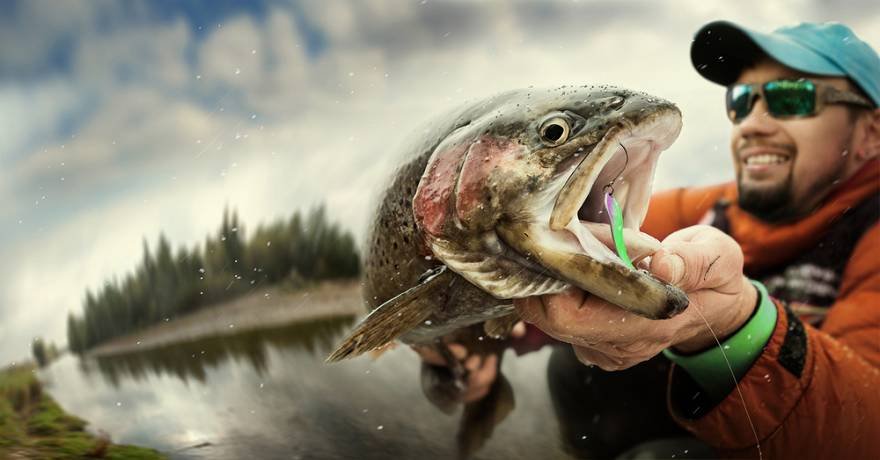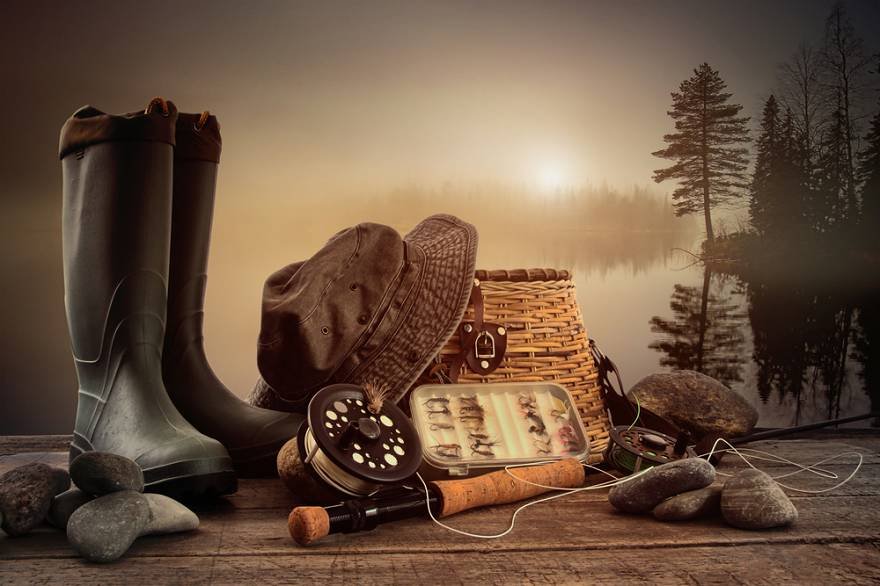There’s something special about stepping out to connect with nature, especially after a long week of working hard. Fly-fishing is one of the best proven ways to help you unwind. I’m one of those people who barely have time even for themselves throughout the week, but once the weekend sets in and Mother Nature is equally cooperating, it’s without a doubt that fly-fishing is all that crosses my mind.
The best part is that you don’t need a special pool or pond, because you can do the fishing at the river, stream or any other feature near you. The reasons why you always have to dress appropriately for different occasions is that each involves activities which demand that you dress in a certain way.
Having said that, fly-fishing is not different from other errands that you can run when you are free. So with the longer hours you’ll be spending outdoors probably under extreme weather conditions, you definitely need to cover up properly.
Having trouble figuring out what to wear fly-fishing? It’s simple; just ensure all your body parts are protected at all times as explained by specialists like fishingkris. But we understand that the term simple isn’t definite, that’s why we will walk you through the various protective gear that you must have before you decide to embark on fly-fishing. Besides the best fly fishing starter kit, here’s a list of ten things that you should bring along:

What to wear Fly-fishing
Fishing vest
Fly-fishing involves both hands, so you won’t have space to carry any additional items on your hands and this is where a fly-fishing vest comes-in handy. There’re different vests that you can choose from, but a good vest should have enough pockets to accommodate everything you need when fishing. These range from weights, lines, flies or even your personal items.
The pros don’t only lie on the storage bit, but also on the fact that these vests bring additional warmth to the body. Another plus for them is that they’re often made with waterproof fabrics, ensuring that whatever it is that you keep in those pockets remain dry and in good shape.
Therefore, you can even bring along you credit cards if you have to. You never know when you might need them.
Sunscreen lotion
Most people consider fly-fishing at least when it’s a bit sunny outside unlike when it’s chilly and all that. Summer is usually all fun until you have to battle constant skin damage throughout the season. Therefore to keep your skin safe, this is a must-have. Earlier on, we talked about covering up. However, it’s not a guarantee that the clothes will cover up your body completely.
Always apply sunscreen on the parts that are left exposed for maximized protection. I always put enough emphasis on whatever brand of sunscreen I use because one wrong move will have you dealing with a whole different mess. In the market today, you’ll find all kinds of products, both counterfeits and genuine.
So it’s always ideal to ensure you’re investing in reputable brands, to get value for your money. They may appear costly compared to the rest of the products that you come across at the store, but they’re definitely worth it.

Fishing hat
There’s more to hats than just fashion. One thing I love about fly-fishing is how relaxed it makes you feel. You don’t have to be strapped in something that your body isn’t used to. Most of these clothing are part of our everyday closet, so there’s no need of buying extra stuff for an activity that you might be doing maybe once a month or sometimes even quarterly.
Having a hat on will keep your head and face covered from direct sunrays and excess heat. Being a shied from heat, it should be made with breathable materials to avoid sweat accumulating on your head. Hence, if you have hats that match these specifications in your collection, just carry one the next time you’re stepping out for fly-fishing.
Rain coat
Before you start wondering how a raincoat made it to this list, there’re certain things to make clear. It doesn’t matter if you’re one of those who only go fishing on sunny days because personally I can’t even count the number of times my weather prediction Apps have failed me.
One moment you’re out having fun with your teammates, enjoying the cool sunny days and then suddenly there’s a downpour, literally out of nowhere. What do you do? Stop whatever it is that you were doing and run for shelter? Of course not. This is where the rain jacket comes in.
It’s always appropriate to carry a lighter jacket with you in case you also live in areas with unpredictable weather conditions like me. I often mark this gear as an emergency piece of cloth that I always have to carry along.
Sunglasses
You should not only have your sunglasses on when you predict your eyes will be exposed to sunrays for extended hours. Even staring at the water alone, on a sunny day, leaves your eyes and face exposed to the harmful UV rays found above the water, from which you’ll be fly-fishing.
However, you shouldn’t get worried about going through the hustle of acquiring a specific set of sunglasses for this activity. You can still rely on the pieces that you already have because any would work just perfectly.
Better still, if you’re always particular about what you wear and won’t mind spending a couple of extra dimes, you can find an amazing collection of fly-fishing sunglasses here.

Waders
Fly-fishing in a regular pant isn’t one of the things that I would recommend, particularly if you prefer depths. Most of the materials used for such aren’t waterproof, like it’s the case with jeans and cotton. Once such fabrics get wet, they bring in additional weight, which will start dragging you, making you uncomfortable.
But with waders, you have absolutely nothing to worry about. They’re waterproof so you won’t be limited to fishing on the banks. You can go after the fish as far as you can. However, depending on where you’re fly-fishing, you should be careful with going deeper into the water to avoid drowning.
Wader boots
Wader boots go hand in hand with waders, and that’s why most suppliers offer them as an item. They offer maximum protection, even if you have to go deeper into the waters when fishing because they’re also waterproof. The precaution here is that you shouldn’t only rely on a single pair of wader boots, especially if you regularly go fly-fishing.
When it comes to footwear, it’s recommended to alternate shoes, to avoid shoe or foot odours and we all know how embarrassing these can be. At the same time, allowing your feet to breathe improves on air circulation, eliminating chances of unnecessary injuries. Another thing about shoes in general is that comfort is all that matters.
While I can’t go fly-fishing with nothing other than knee-high boots, I have friends who can do just fine with flip-flops! All I’m trying to say is that if you can strike a balance between comfort and protection then you’re one of the luckiest people I know. Come to think of it, what’s the point of killing your feet with boots when you can be careful enough to keep your legs and feet safe the entire time?

Socks
With wader boots on, you can’t miss to have a decent pair of socks on. Irrespective of what the weather looks like, socks always keep the feet safe from unnecessary friction, which often leads to foot injuries. One thing to remember is to layer up according to the temperatures, that is; go lighter when it’s relatively hot and thicker when winter kicks in.
Being a form of padding on its own, socks can either keep your feet warm or sweaty. Hot temperatures usually call for moisture wicking socks in order to keep the feet dry and comfortable. So, if you have some cotton socks somewhere, please keep them for winter.
Wader belt
When you have decided to flow with waders, you need to equip yourself with a wader belt. If all of these are new and you’re probably wondering what a wader belt looks like, here are some examples that you can browse through. So basically, waders, wader boots, socks and wader belts forms the real fly-fishing starter pack.
For those who care about how they look no matter what occasion it is, you can give your fashion a plus by buying quality complementary pieces. However, there are no rules and you can also bring in your regular belt, provided that it can securely keep the wader in place. Failure to do so will have the wader dragging a lot of weight and friction around the waist area and can make you sustain serious injuries.
Neoprene gloves
We’ve talked about protective gears for the rest of the body parts, how about something for the hands? Something to note is that with a lot of handy work, it might get a bit hectic fly-fishing with heavy gloves on. Thus, unlike sunglasses, you can’t pick any hand gloves that you come across.
Apart from the weight, you need a pair of gloves that will keep your hands safer from any harmful elements because not all fabrics do. You’ll find everything you need in a neoprene glove due to its superiority when it comes to layers. There are affordable pieces from which you can choose from because there’s always something for everyone.
Just like socks, leaving these gloves on your hands for longer hours might make you feel uncomfortable, especially if it’s a bit hot outside. When buying gloves, you need to know your hand measurements in order to pick a perfectly fitting pair, which won’t feel too tight on the hands, or one that will require frequent adjustments.

Conclusion
Protective gear alone cannot keep you completely safe. So you have to take other precautions. For example, when you’re going out all by yourself, ensure that you avoid isolated areas and that you don’t stay out late in the night. This plays a greater role in keeping you safe from attacks and accidents.
In addition to that, see to it that you don’t stay under extreme weather conditions for extended hours. The longer you remain exposed to such conditions, the higher the health risks. And as I had mentioned earlier, only explore depths that you’re sure about to avoid drowning. Do you have other ideas on what to wear fly-fishing that you would want to share with us?
We do welcome other great options as well. If you haven’t started fly-fishing yet, just know that you’re probably missing out on a number of great things. With the right checklist, I believe you’ll have the most memorable fly-fishing when you’re out with your loved ones, or all by yourself.
